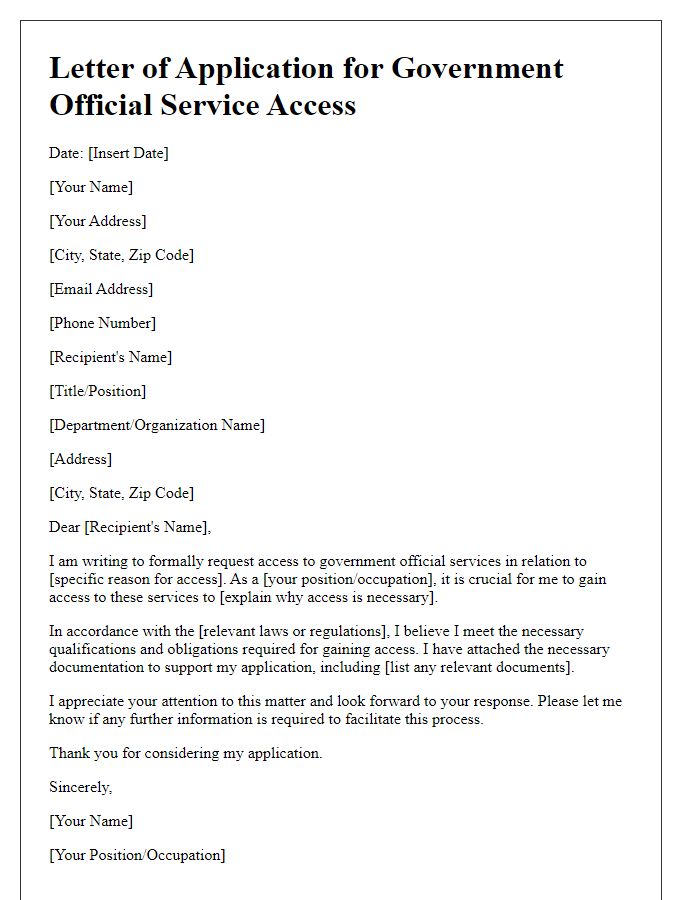When it comes to writing to government officials, having a well-structured letter template is key to ensuring your message is clear and effective. Whether you're addressing a concern, requesting information, or expressing gratitude, the tone and format can make a significant difference. Using a concise and respectful approach will help you convey your points effectively while also capturing the official's attention. If you're eager to learn how to craft the perfect letter, keep reading for our detailed guide!

Formal Language and Tone
Government official communication often requires a formal tone and structured language. Accuracy and clarity are vital. Essential components include an official heading, salutation, clear body content, and proper closing. Correspondence typically addresses specific matters, policies, or requests relevant to public administration or civil service issues. Important identifiers such as reference numbers, relevant dates, and sender or recipient addresses ensure proper tracking and response by officials. A respectful and professional demeanor, appropriate for the context of governance, underscores the importance of the subject matter at hand.
Accurate Recipient Details
Accurate recipient details are crucial for effective communication in official correspondence. Full names ensure proper identification, including titles such as "Honorable" or "Dr." especially when addressing government officials like mayors or senators. Exact mailing addresses (street number, name, city, state, zip code) streamline the delivery process and prevent delays. Department names (such as Department of Education) clarify the subject of the letter, ensuring it reaches the appropriate office. Contact numbers (including area code) offer additional means of follow-up. Email addresses allow for quicker communication, especially when dealing with time-sensitive matters. Using official letterhead, when applicable, signifies the legitimacy and formality of the correspondence.
Specific Purpose and Request
Government officials often require clear and organized communication to address specific purposes and requests effectively. When drafting a letter to a government official, it's essential to clearly state the purpose of the communication, include relevant details, and outline the specific request. This typically involves mentioning the official's title, the governmental department or agency, and any pertinent deadlines or impacts related to the request. Including supporting data or documents can strengthen the request, and expressing gratitude for the official's time and consideration can foster a positive tone.
Relevant Supporting Information
An effective government official service letter requires clear and concise supporting information, often including relevant data, context, and identifiers. For instance, referencing established regulations, such as the Freedom of Information Act (FOIA) for information requests, can enhance clarity. Additionally, incorporating specific case numbers, such as those pertaining to ongoing investigations or public records requests, can provide essential tracking details. Highlighting critical dates, like deadlines for document submission or responses, contributes to understanding urgency. Citing contact points, such as official email addresses or phone numbers, allows for streamlined communication. Finally, mentioning pertinent governmental departments or offices, like the Department of Health or local zoning boards, can contextualize the subject matter effectively.
Professional Closing and Signature
Professional closing statements for government official correspondence should maintain a formal tone. Common closings include "Sincerely," "Respectfully," or "Yours faithfully." These phrases convey professionalism and respect, essential in government communications. Following the closing, include a signature line where the official's name appears, along with their title, department, and contact information. For example, "John Doe, Director of Communications, Department of Public Safety, john.doe@govagency.org." This layout ensures clarity and accountability in correspondence, vital in government exchanges, especially when addressing constituents or stakeholders within government service.
Letter Template For Government Official Service Samples
Letter template of notification of change in government official service needs













Comments